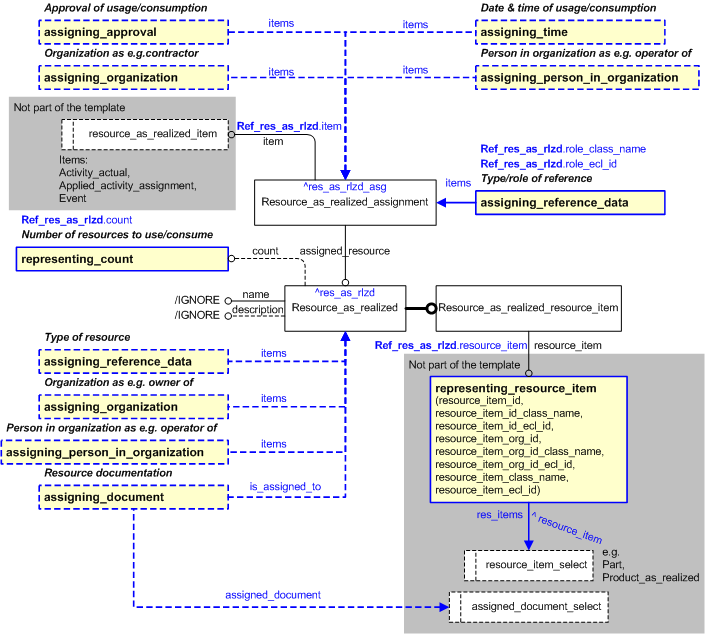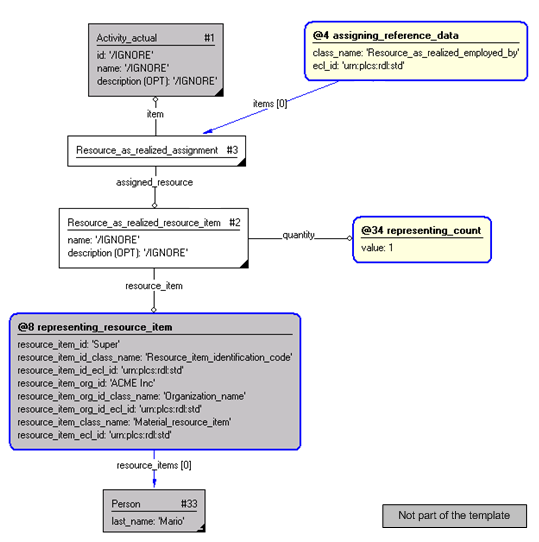Capability:representing_resource_as_realized
Revision: 1.11
| Template:— referencing_resource_as_realized (ref_res_as_rlzd) Capability:representing_resource_as_realized |
Date: 2008/01/14 08:43:55 Revision: 1.11 |
The use of template,referencing_resource_as_realized, has been deprecated since 2007-10-19.
Use assigning_realized_resource instead.This section specifies the template referencing_resource_as_realized.
NOTE The template has been defined in the context of the capability representing_resource_as_realized which provides an overall description of the relevant parts of the ISO 10303-239 information model and a description of related templates.
NOTE An explanation of a template and the associated instantiation path is provided in the Template overview section.
This template describes how to reference a Resource_as_realized_resource_item, which is used to represent tokens of resources that are actually used or consumed or that are intended for use or consumption.
NOTE This template should only be used when referencing a Resource_as_realized_resource_item.


target
is the parameter to which the
Resource_as_realized_assignment
is bound.
target
is the parameter to which the
Resource_as_realized
is bound.
| Entity in path | Value | Inherited from |
| Resource_as_realized_resource_item.name | '/IGNORE' | Resource_as_realized.name |
| Resource_as_realized_resource_item.description | '/IGNORE' | Resource_as_realized.description |

#1 = ACTIVITY_ACTUAL('/IGNORE','/IGNORE','/IGNORE',$); #2 = RESOURCE_AS_REALIZED_RESOURCE_ITEM('/IGNORE','/IGNORE',#35,#9); #3 = RESOURCE_AS_REALIZED_ASSIGNMENT(#2,#1); #5 = CLASSIFICATION_ASSIGNMENT(#6,(#3),'/IGNORE'); #6 = EXTERNAL_CLASS('/IGNORE','Resource_as_realized_employed_by','/IGNORE',#7); #7 = EXTERNAL_CLASS_LIBRARY('urn:plcs:rdl:std',$); #9 = RESOURCE_ITEM('/IGNORE','/IGNORE',(#33)); #11 = IDENTIFICATION_ASSIGNMENT('Super','/IGNORE',$,(#9)); #13 = CLASSIFICATION_ASSIGNMENT(#14,(#11),'/IGNORE'); #14 = EXTERNAL_CLASS('/IGNORE','Resource_item_identification_code','/IGNORE',#15); #15 = EXTERNAL_CLASS_LIBRARY('urn:plcs:rdl:std',$); #17 = ORGANIZATION('/IGNORE','/IGNORE'); #19 = IDENTIFICATION_ASSIGNMENT('ACME Inc','/IGNORE','/IGNORE',(#17)); #21 = CLASSIFICATION_ASSIGNMENT(#22,(#19),'/IGNORE'); #22 = EXTERNAL_CLASS('/IGNORE','Organization_name','/IGNORE',#23); #23 = EXTERNAL_CLASS_LIBRARY('urn:plcs:rdl:std',$); #24 = ORGANIZATION_OR_PERSON_IN_ORGANIZATION_ASSIGNMENT(#17,'/IGNORE',(#11)); #26 = CLASSIFICATION_ASSIGNMENT(#27,(#24),'/IGNORE'); #27 = EXTERNAL_CLASS('/IGNORE','Owner_of','/IGNORE',#28); #28 = EXTERNAL_CLASS_LIBRARY('urn:plcs:rdl:std',$); #30 = CLASSIFICATION_ASSIGNMENT(#31,(#9),'/IGNORE'); #31 = EXTERNAL_CLASS('/IGNORE','Material_resource_item','/IGNORE',#32); #32 = EXTERNAL_CLASS_LIBRARY('urn:plcs:rdl:std',$); #33 = PERSON('Mario','Super',$,$,$); #35 = VALUE_WITH_UNIT(#36,1); #36 = UNIT('/IGNORE','false'); #38 = CLASSIFICATION_ASSIGNMENT(#39,(#36),'/IGNORE'); #39 = EXTERNAL_CLASS('/IGNORE','Count','/IGNORE',#40); #40 = EXTERNAL_CLASS_LIBRARY('urn:plcs:rdl:std',$);
NOTE this characterization is optional.
The Approval of using or consuming a Resource_as_realized.
NOTE The assignment of Approval is described in the capability C019: assigning_approvals.
NOTE this characterization is optional.
The assigned Date_time state the actual ('Date_actual'), planned ('Date_planned'), or predicted ('Date_predicted') date and time when the referenced Resource_as_realized was, is planned, or is predicted to be used or consumed. Naturally, the type of assigned Date_time is constrained by the resource_as_realized_item referencing the Resource_as_realized, e.g. if an Activity_actual is referencing a Resource_as_realized the assigned Date_time should be of type 'Date_actual' and not 'Date_planned' or 'Date_predicted'.
NOTE The assignment of Date_time is described in the capability C036: assigning_date_time.
NOTE this characterization is optional.
An Organization that is related to a Resource_as_realized_assignment or a Resource_as_realized, e.g. as a contractor or operator of the resource..
NOTE The assignment of Organization is described in the capability C094: assigning_organization.
NOTE this characterization is optional.
A Person_in_organization that is related to a Resource_as_realized_assignment or a Resource_as_realized, e.g. as an operator of the resource.
NOTE The assignment of Person_in_organization is described in the capability C016: representing_person_organization.
NOTE this characterization is optional.
Reference data defining the type of Resource_as_realized_resource_item, e.g. a human, material or financial resource.
NOTE The assignment of External_class is described in the capability C010: assigning_reference_data.
NOTE this characterization is optional.
Documentation of the Resource_as_realized.
NOTE The assignment of Document, Document_version or Document_definition is described in the capability C005: representing_documents.
© OASIS 2010 — All rights reserved